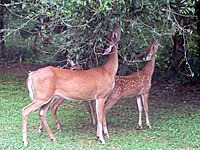
Photo from wikipedia
Deep snow can reduce accessibility to vegetation and cover by herbivores by blanketing understory cover, yet simultaneously increase access to foliage at higher levels. Thus, snow depth fluctuation should lead… Click to show full abstract
Deep snow can reduce accessibility to vegetation and cover by herbivores by blanketing understory cover, yet simultaneously increase access to foliage at higher levels. Thus, snow depth fluctuation should lead to spatiotemporal variation in herbivore habitat use. We measured shifts in habitat use by snowshoe hare (Lepus americanus Erxleben, 1777) as a function of snow depth in an eastern Canadian boreal forest where snow depth often exceeds 1 m. We hypothesized that as snow accumulates, snowshoe hares shift from locations with dense vegetation just above ground to locations with dense vegetation higher above ground. We surveyed 58 km of transects over three winters and found 1954 hare tracks. We analyzed track counts as a response to a density index of low vegetation (0–1.5 m above ground), high vegetation (2–4 m above ground), predator tracks, and snow depth. We found more hare tracks in sites with dense high vegetation when snow was deeper, and more hare tracks in sites with dense low vegetation when sn...
Journal Title: Canadian Journal of Zoology
Year Published: 2017
Link to full text (if available)
Share on Social Media: Sign Up to like & get
recommendations!